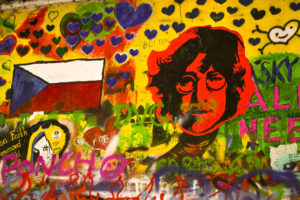Prague is an eternal city. A goddess with multiple faces. A journey through the time, which opens the doors of the history from which the city itself is surrounded. Each step enchants the spectator’s eyes who is magically transported to other worlds like in a dream. The streets surrounded by buildings with refined architecture, flow through the streets and transform the atmosphere into a union between beauty and history. The Streets have been surrounded by thousands of decorative tinsels, windows, balconies, churches, cathedrals, gates, streets, towers, bridges. Following these features, the city center is a real open space museum. Honestly, art museums in Prague are not short in number. In fact, there are many of them. However, just taking a walk around downtown is sufficient to see one of the best art museums in Europe. The shadows of the past intensify at every crossroads.
“In Prague, classical architecture becomes romantic and romantic architecture absorbs the classic characters, to give surreal humanity character to the territory. Both architectural genres, become cosmic not in the sense of abstract order, but as transcendent aspiration. Evidently, Prague is one of those great centers where a multitude of meanings agree. ” (Christian Norberg-Schulz)
Prague is surrounded by Romantic, Gothic, Renaissance, Baroque, Neo-Renaissance, Art Nouveau, Cubism, post-revolution modernism (1989). The emotions have mixed and reality becomes narrower for abandoning itself to the eternal. Traces of communism are evident from that moment when Soviet troops invaded the former Czechoslovakia (1968). Those are visible over a long series of palaces (Paneláks), hotels (Hotel International), monuments which are present in a short number (Kosmonautů). An historical response to the occupation is exposed on the famous Wall dedicated to John Lennon. At the same time, the memory of the violence is visible in the monument to the victims of communism. Although, the art has been established everywhere over the centuries, Prague continues to follow the evolution of young artists and their avant-garde ideas. Attention to what is new, it is the basement which the roots of the new age must be founded on. A concise list of some museums and galleries below.
DOX Center for Contemporary Art
Founded in 2008, it is a large center of contemporary art. Over the years, the DOX has become an important attraction point for art lovers, who choose the center of contemporary art as a necessary meeting point. Over the years, it has hosted more than 100 exhibitions. The center focuses on unconventional artists, provocateurs who address the problems of contemporary society.
Leica Gallery Prague
Founded in 2002 and located in the heart of Prague. The Gallery offers an average of six or seven exhibitions a year, focusing on photographic art. The hosted artists are mostly citizens of the Czech Republic or Slovakia. The idea is the promotion of local photography on the world scene.
MeetFactory
Founded in 2001 by the Czech sculptor David Cerny, it is a non-profit center dedicated to contemporary art. The goal is to create a dialogue between genres, making art more accessible to the public.
The Chemistry Gallery
It is a space dedicated to young artists. The main idea is to build a space where the public can interact and discover these young artists from all over the world.
http://www.thechemistry.cz/en/
Simone Santarelli
 David Cerný, Red Skull, installation view in 2014 at DOX Centre for Contemporary Art
David Cerný, Red Skull, installation view in 2014 at DOX Centre for Contemporary Art
 The Lennon Wall, 1980 – created to be a symbol of peace and freedom – Photo © Simone Santarelli
The Lennon Wall, 1980 – created to be a symbol of peace and freedom – Photo © Simone Santarelli
 Michalina Bigaj, Disingenuous Nature, 2017 installation at Gallery Kostka Photo © Tomáš Souček
Michalina Bigaj, Disingenuous Nature, 2017 installation at Gallery Kostka Photo © Tomáš Souček
 Free exhibition of contemporary art, 2016 – Charles Bridge Photo © Simone Santarelli
Free exhibition of contemporary art, 2016 – Charles Bridge Photo © Simone Santarelli

is a contemporary art magazine since 1980




NO COMMENT